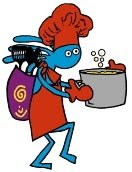Happy Holidays from Kokopelli's Kitchen!
You won’t find them in the Bible, but many cherished Easter traditions—from the Easter bunny to decorating and hunting for eggs—have been around for centuries.
Easter Bunny
The Bible makes no mention of a long-eared, short-tailed creature who delivers decorated eggs to well-behaved children on Easter Sunday; nevertheless, the Easter bunny has become a prominent symbol of Christianity's most important holiday. The exact origins of this mythical mammal are unclear, but rabbits, known to be prolific procreators, are an ancient symbol of fertility and new life. According to some sources, the Easter bunny first arrived in America in the 1700s with German immigrants who settled in Pennsylvania and transported their tradition of an egg-laying hare called "Osterhase" or "Oschter Haws." Their children made nests in which this creature could lay its colored eggs. Eventually, the custom spread across the U.S. and the fabled rabbit's Easter morning deliveries expanded to include chocolate and other types of candy and gifts, while decorated baskets replaced nests. Additionally, children often left out carrots for the bunny in case he got hungry from all his hopping.Easter Eggs
Easter is a religious holiday, but some of its customs, such as Easter eggs, are likely linked to pagan traditions. The egg, an ancient symbol of new life, has been associated with pagan festivals celebrating spring. From a Christian perspective, Easter eggs are said to represent Jesus' emergence from the tomb and resurrection. Decorating eggs for Easter is a tradition that dates back to at least the 13th century, according to some sources. One explanation for this custom is that eggs were formerly a forbidden food during the Lenten season, so people would paint and decorate them to mark the end of the period of penance and fasting, then eat them on Easter as a celebration.Easter egg hunts and egg rolling are two popular egg-related traditions. In the U.S., the White House Easter Egg Roll, a race in which children push decorated, hard-boiled eggs across the White House lawn, is an annual event held the Monday after Easter. The first official White House egg roll occurred in 1878, when Rutherford B. Hayes was president. The event has no religious significance, although some people have considered egg rolling symbolic of the stone blocking Jesus' tomb being rolled away, leading to his resurrection.
Easter Candy
Easter is the second best-selling candy holiday in America, after Halloween. Among the most popular sweet treats associated with this day are chocolate eggs, which date back to early 19th century Europe. Eggs have long been associated with Easter as a symbol of new life and Jesus' resurrection. Another egg-shaped candy, the jelly bean, became associated with Easter in the 1930s (although the jelly bean's origins reportedly date all the way back to a Biblical-era concoction called a Turkish Delight). According to the National Confectioners Association, over 16 billion jelly beans are made in the U.S. each year for Easter, enough to fill a giant egg measuring 89 feet high and 60 feet wide. For the past decade, the top-selling non-chocolate Easter candy has been the marshmallow Peep, a sugary, pastel-colored confection. Bethlehem, Pennsylvania-based candy manufacturer Just Born (founded by Russian immigrant Sam Born in 1923) began selling Peeps in the 1950s. The original Peeps were handmade, marshmallow-flavored yellow chicks, but other shapes and flavors were later introduced, including chocolate mousse bunnies.Easter Parade
In New York City, the Easter Parade tradition dates back to the mid-1800s, when the upper crust of society would attend Easter services at various Fifth Avenue churches then stroll outside afterward, showing off their new spring outfits and hats. Average citizens started showing up along Fifth Avenue to check out the action. The tradition reached its peak by the mid-20th century, and in 1948, the popular film Easter Parade was released, starring Fred Astaire and Judy Garland and featuring the music of Irving Berlin. The title song includes the lyrics: "In your Easter bonnet, with all the frills upon it/You'll be the grandest lady in the Easter parade."The Easter Parade tradition lives on in Manhattan, with Fifth Avenue from 49th Street to 57th Street being shut down during the day to traffic. Participants often sport elaborately decorated bonnets and hats. The event has no religious significance, but sources note that Easter processions have been a part of Christianity since its earliest days. Today, other cities across America also have their own parades.
(Source: The History Channel. Retrieved April 7, 2012.)



